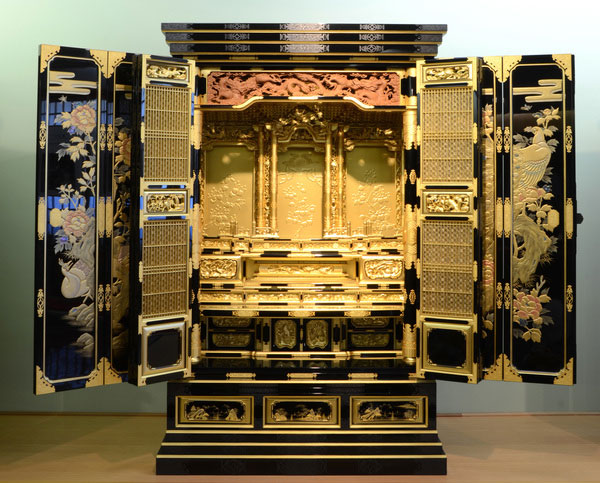
- Household Buddhist altars
- Nagano
Iiyama Buddhist altar Iiyama butsudan
Stunning design with stereoscopic effects
that reflect the Buddhist mindset
Description
What is Iiyama Buddhist altar ?
Iiyama Buddhist Altars, called Iiyama Butsudan in Japanese, are made around the city of Iiyama, Nagano prefecture. Iiyama is known for its people being devout to Buddhism since ancient times, which sustains the tradition of altar production. This craft is distinct because of its unique yumi nageshi or wooden arch above the inner sanctuary which makes the inner sanctuary and elaborate maki-e* decorations on the altar clearly visible. Three-dimensional gold leaf maki-e is applied to the altar with multiple careful coats of lacquer. The arched nageshi which is set above the inner sanctuary, makes praying before the sanctuary easier. Iiyama Buddhist Altars are considerate of those who pray before the altars in this way, so it can be said that the Iiyama Buddhist Altars are filled with Iiyama's deep faith in Buddhisim. This craft was recognized as a traditional craft in 1975, and even today has shipments of a thousand altars per year.
*A fine brush is used to paint a picture with lacquer on the surface and gold powder is sprinkled on the surface before it dries, creating a design.
History
The origin of Iiyama Buddhist Altars is unknown, but one theory is that a man named Shigetaka TERASE moved to Iiyama from Kofu, Yamanashi prefecture in 1689 and built a plain Buddhist altar out of wood, which evolved to become this craft. Iiyama is known for being the place where the Jodo Shinshu branch of Buddhism was introduced during the Muromachi period (1336-1573). It is also known as the place where a devout Buddhist, Kenshin UESUGI constructed the Iiyama Castle during the Sengoku period (1467-1603), making Iiyama a prosperous castle town. It was in this context that Iiyama Buddhist altars could naturally develop. Initially, the altars were much plainer and simpler from how they appear today. The simple unfinished wood altars evolved into their current grand state with the start of lacquer coating during the Edo period (1603-1863), and were later established as a craft during the late Edo period by master artisan Kisaku INABA. Today, traditional production processes are carried on. There are approximately a hundred and fifty artisans, and Iiyama is a leading national area of altar production.
General Production Process
- 1. Wooden base
The parts for the wooden base of the altar are made at this stage. Iiyama Buddhist altars mainly use wood from Japanese white pine, Japanese cedar, and Japanese Judas tree, but Japanese cypress is sometimes used for luxurious altars. The wood is carefully selected and marked with protrusions and recesses for the assembly parts. The wooden base is built to enable easy assembly and disassembly on repairing and repainting aged parts.
- 2. Inner sanctuary
The wooden inner sanctuary is the main part of the Buddhist altar and is located in the center of the altar. The artisan carefully assembles the elaborate parts. The work becomes even more delicate for the larger altars, as most large altars have dual sanctuaries. The use of wood joinery called hijiki kumimono is a unique technique to this craft, which allows easy assembly and disassembly by removing the hijiki or ancon.
- 3. Wood sculpture
Flowers, plants, birds, or animals are carefully carved in the wooden yumi nageshi or arches using different kinds of chisels and knives.
- 4. Lacquering
Lacquering is a process of repeatedly painting the surface evenly with the base coat, middle coat and black lacquer and then burnishing to smooth the surface. Repeating this procedure adds a glossy finish and resonance to Iiyama Buddhist altars.
- 5. Metal fittings
Metal fittings are handcrafted for Buddhist altars, with various patterns engraved in copper or brass sheets. Notably, the metal is processed with plum vinegar to give greater durability.
- 6. Maki-e
Iiyama Buddhist altars are famous for its gorgeous maki-e. Maki-e is a technique of drawing designs like peacocks, tree peony and phoenixes on a lacquer painted surface. Whitewash made from seashells, called gofun, is used as pigment, raising the pattern to apply a three-dimensional appearance. After painting with whitewash, the maki-e pattern is sprinkled with gold powder, giving an elegant effect.
- 7. Gilding
Gilding is important to maintain a beautiful altar in good condition. Gold leaf is carefully layered over a lacquer painted surface before it dries and is wiped with floss silk.
- 8. Assembly
The quality of the wooden base and lacquering is checked thoroughly at this stage. Metal fittings are hammered with a hammer made of the same material as the metal fitting, copper or brass, for rust prevention. All the parts that have been checked are assembled to complete the altar.
Where to Buy & More Information
Iiyama Dento Sangyo Kaikan
-
Address
-
Tel.+81-269-62-4019
-
ClosedMondays (open if Monday is holiday and closed the next day), December 29 to January 3
-
Business Hours9am to 5pm
-
Website
See more Household Buddhist altars
- Osaka Buddhist altar
- Hikone Buddhist altar
- Iiyama Buddhist altar
- Nagoya Buddhist altar
- Kanazawa Buddhist altar
- Kawanabe Buddhist altar
- Kyo Buddhist altar
- Hiroshima Buddhist altar
- Mikawa Buddhist altar
- Kyo Buddhist altar equipment
- Nanao Buddhist altar
- Yamagata Buddhist altar
- Yame-fukushima Buddhist altar
- Nagaoka Buddhist altar
- Sanjo Buddhist altar
- Niigata-shirone Buddhist altar
- Owari Buddhist altar equipment































































































































































































































































































